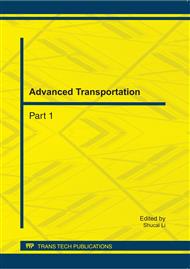p.825
p.831
p.837
p.843
p.849
p.854
p.859
p.863
p.867
An Ensemble Learning Short-Term Traffic Flow Forecasting with Transient Traffic Regimes
Abstract:
Short-term traffic flow forecasting has a rich and substantive research history. For layered hybrid forecasting approaches, traffic flow series are classified into distinct regimes based on characteristics of different traffic conditions so that regime-specific forecasting models can be trained to adequately and consistently approximate dynamic traffic dynamic behaviors. However, traffic regimes are inherently changing and transient, making it a challenging task to perform regime-specific forecasting. In this paper, an ensemble learning approach is proposed and regime-based forecasting models are developed to address the nonlinearity and non-stationarity of traffic flow data. Case study results demonstrate that the proposed approach can effectively account for transient regimes and produce accurate online short-term traffic forecasts.
Info:
Periodical:
Pages:
849-853
Citation:
Online since:
September 2011
Authors:
Keywords:
Price:
Сopyright:
© 2011 Trans Tech Publications Ltd. All Rights Reserved
Share:
Citation:


